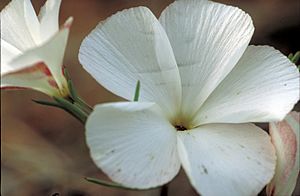Evening-snow facts for kids
Quick facts for kids Evening-snow |
|
|---|---|
 |
|
| Scientific classification | |
| Genus: |
Linanthus
|
| Species: |
dichotomus
|
Linanthus dichotomus is a beautiful flowering plant commonly known as eveningsnow. It gets this special name because its white flowers often open in the evening, making them look like fresh snow. This plant grows naturally in western North America, especially in the southwestern United States. You can find it in many different types of habitats.
Contents
About the Eveningsnow Plant
Eveningsnow is an annual plant, which means it completes its entire life cycle, from seed to flower to seed, in just one year. It's also an herbaceous plant, meaning it has soft, green stems rather than woody ones like trees or shrubs.
What Does It Look Like?
This plant usually grows several thin, waxy stems that stand upright. These stems can reach about 20 centimeters (about 8 inches) tall. Its leaves are divided into narrow, finger-like parts called lobes, which are typically 1 to 2 centimeters long.
Its Special Flowers
The flowers of the eveningsnow plant grow in a special arrangement called a cyme. This means the oldest flowers are in the center, and newer ones grow on the sides. These flowers are described as vespertine, which means they usually open in the evening and close by morning.
When the flowers open, their petals unroll into a funnel shape. The main parts of the flower, called lobes, are white and are just over a centimeter long. If you look closely, you might see a pretty purple shading on the undersides of these white lobes.
Where Does It Grow?
Eveningsnow is a common plant in many areas of the southwestern United States. It particularly likes to grow in serpentine soils, which are a special type of soil found in places like California. These soils are often rich in certain minerals and can be challenging for many other plants, but eveningsnow thrives there.

